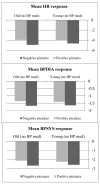Interoception in Old Age
- PMID: 36291331
- PMCID: PMC9599927
- DOI: 10.3390/brainsci12101398
Interoception in Old Age
Abstract
Emotion regulation in old age was found to be more efficient; seniors seem to focus less on the negative aspects of experiences. Here, we ask, do older individuals regulate their emotions more efficiently or are they numb to the physiological changes that modulate these emotions? Interoception, the perception of physical feelings, influences a person's mood, emotions, and sense of well-being, and was hardly tested among older adults. We examined the awareness of physiological changes (physiological arousal-blood pressure and heart rate) of 47 older adults, compared to 18 young adults, and their subjective reports of emotional experiences while viewing emotional stimuli. Interoception was decreased in old age. Blood pressure medications had a partial role in this reduction. Moreover, interoception mediated emotional experience, such that low interoception led to lower experiences of changes in physiological arousal. These findings may account for the emotional changes in old age, suggesting a decline in sensitivity with age, which leads to a positive interpretation of information.
Keywords: emotional experience; interoception; old adults; physiological arousal.
Conflict of interest statement
The authors declare no conflict of interest.
Figures




References
-
- James W. What is an emotion? Mind. 1884;9:188–205. doi: 10.1093/mind/os-IX.34.188. - DOI
-
- Ekman P., Cordaro D. What is meant by calling emotions basic. Emot. Rev. 2011;3:364–370. doi: 10.1177/1754073911410740. - DOI
-
- Lazarus R.S. Psychological Stress and the Coping Process. McGraw-Hill; New York, NY, USA: 1996.
LinkOut - more resources
Full Text Sources

